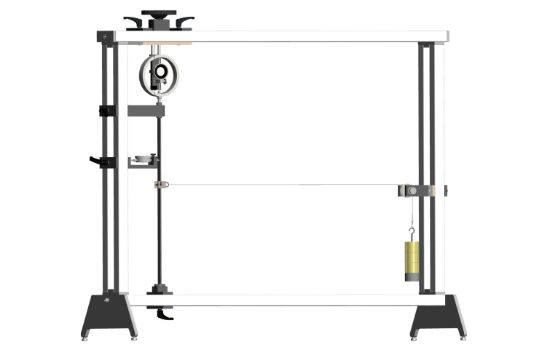Long and slim components such as bars, beams and columns are often subjected to compressive forces along their long axis owing to their function. Under the influence of critical compressive forces, such components can lose stability and deform laterally. The technical term for this loss of stability, which occurs suddenly or continuously, is buckling. In this case, it is not the material that fails but the component shape. The stresses in the bar are often still in the elastic region.
The SE 110.57 unit can be used to clearly demonstrate the elastic buckling of bars under various influences. In this experiment, a bar is clamped or supported at both ends, depending on the buckling case. A load mechanism applies a compressive force to the bar. The applied force is measured and displayed on a force gauge. A dial gauge indicates the lateral deflection of the bar. This experiment also demonstrates that other factors affect the buckling behaviour, such as the material and the cross-sections. Another experiment shows the influence of additional shear forces. In this experiment, a shear force is applied to the joint in the buckling bar through a cable and a weight.
The parts of the experiment are clearly laid out and securely housed in a storage system. The entire experimental setup is constructed in the SE 112 mounting frame.

Buckling of bars
Long and slim components such as bars, beams and columns are often subjected to compressive forces along their long axis owing to their function. Under the influence of critical compressive forces, such components can lose stability and deform laterally. The technical term for this loss of stability, which occurs suddenly or continuously, is buckling. In this case, it is not the material that fails but the component shape. The stresses in the bar are often still in the elastic region.
The SE 110.57 unit can be used to clearly demonstrate the elastic buckling of bars under various influences. In this experiment, a bar is clamped or supported at both ends, depending on the buckling case. A load mechanism applies a compressive force to the bar. The applied force is measured and displayed on a force gauge. A dial gauge indicates the lateral deflection of the bar. This experiment also demonstrates that other factors affect the buckling behaviour, such as the material and the cross-sections. Another experiment shows the influence of additional shear forces. In this experiment, a shear force is applied to the joint in the buckling bar through a cable and a weight.
The parts of the experiment are clearly laid out and securely housed in a storage system. The entire experimental setup is constructed in the SE 112 mounting frame.
